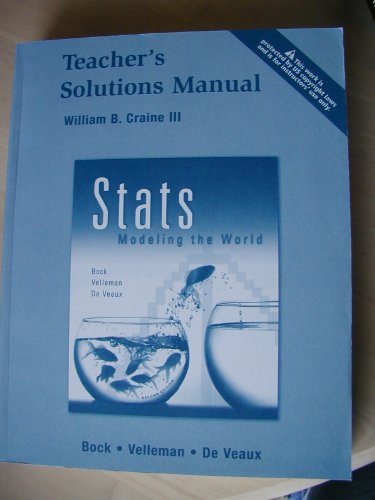

- #STATS MODELING THE WORLD AP EDITION ANSWERS CHAPTER 18 SOFTWARE#
- #STATS MODELING THE WORLD AP EDITION ANSWERS CHAPTER 18 TRIAL#
This distribution is called the sampling distribution model for sample proportions. Before we observe the value of the sample proportion, it is a random variable that has a distribution due to sampling variations. The distribution of the sample proportion is called the sampling distribution model for the proportion. The sample proportion = Y/n has a normal model with mean 0.49 and standard deviation (n=1000) Then we know that both 49% and 45.9 % are reasonable to appear ( )/0.0158=Ĭonsider the sample proportion as a random variable instead of a number. Bush (cont’) Assume the true population proportion voting for Kerry is 49%. The sample proportion Normal model with mean p and variance We figured out the mean and sd of the sample proportions and use the normal model with the same mean and the same sd to approximate the Distribution of the sample proportions.ĥ Kerry vs.
#STATS MODELING THE WORLD AP EDITION ANSWERS CHAPTER 18 SOFTWARE#
Then we used a computer software to simulate repeated samples and look at a histogram of the sample proportions of 2000 samples of size 1000 And noticed that the histogram looks like a normal model. Therefore we can model the total number of respondents who said yes out of 1000 by a binomial random variable.

#STATS MODELING THE WORLD AP EDITION ANSWERS CHAPTER 18 TRIAL#
We may think the process of asking a randomly selected respondent as a Bernoulli trial and the probability that This person says he/she would vote for Kerry is p. That’s is to say, the probability that a randomly selected respondent saying he would vote for Kerry is p. Let p be the proportion of people favoring Kerry in the entire population. Due to the variability of random sampling, every time we draw samples, we have something different.ģ Model Let Y be the number of people favoring Kerry in a sample of size n=1000 Y ~ Binomial(n,p) p: the proportion of people for Kerry in the entire population When n is large, Y can be approximated by Normal model with mean np and variance npq. Two polls A Gallup poll showed 49% and a Rasmussen Poll a week later says 45.9%. We were interested in finding the proportion of population in favor of Kerry. Bush in 2004 A Gallup Poll 49% for Kerry A Rasmussen Poll 45.9% for Kerry Was one poll “wrong” ? Should we be surprised to find that we could get very different proportions from properly selected random samples Why the answers are different? Sample proportion estimates population proportion There is randomness due to sampling Last week we looked the example of 2004 presidential election poll. Bush in 2004 A Gallup PollĤ9% for Kerry 1016 respondents A Rasmussen Poll 45.9% for Kerry 1000 respondents Why the answers are different? Variability of sample Kerry vs. So we could say that based on our 95% confidence interval, we do not find it plausible that the true proportion is 5%.1 Chapter 18 Sampling distribution modelsĢ Sample proportion Kerry vs. Because it's greater than 0.49 It's close, but it's still outside of it. And for Part B, we were told that a staff member actually thinks that the true rate is 5% and based on our confidence interval, do we find this to be plausible so we can see that 5% is outside of our confidence interval at the 95% confidence live level. We're 95% confident that the true proportion is between 0.46 and 0.0 for nine. Value is 1.96 so we can substitute all of the numbers into our formula and we get the following confidence interval for 95% confidence. And so the confidence interval is given by this formula for a 95% confidence interval are critical. So we can conclude that the conditions for inference have been met.

Que is much bigger than our sample proportion, which means that this value would be quite a bit bigger than 4781 which means that they're both bigger than 10. So since this is P, then Q would be one minus that so que are simple.

We would also want to confirm that 100,000 people was less than 10% of the total population of potential donors, which seems plausible, and we want to check that NP and an que are both at least him so we can see from the question that end times P is 4781 and n times Q. We know from the question that they sent out the letters to a random sample of 100,000 potential donors, so that speaks to the independence of the sample of people. Who may donate? When the question We're told that we have a sample size of 100,000 and from our sample, what is the proportion who donate? We're told that 4781 donated out of 100,000, so that means they're sample proportion is zero point zero for 781 The party was to give the 95% confidence interval, so we first want to check that the conditions for a one proportions that interval have been met. So for part, they were asked to give in 95% confidence interval for the true proportion of the entire mailing list. In this exercise, we're told that an organization has reached out to 100,000 potential donors and received 4781 donations.


 0 kommentar(er)
0 kommentar(er)
